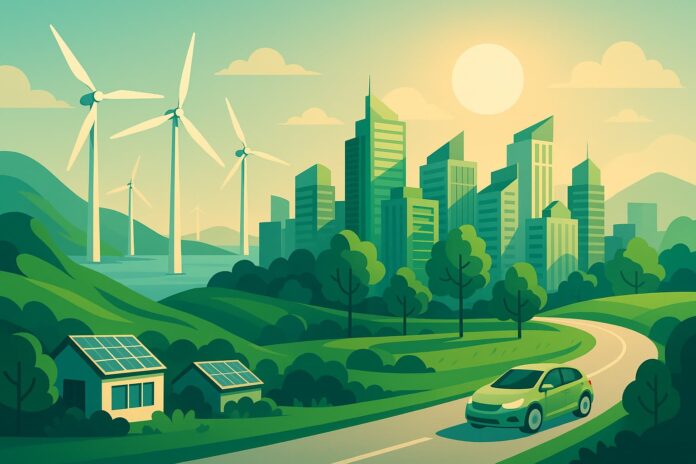The UK is rapidly becoming one of the world’s most forward-thinking centres of sustainability, pioneering cleaner energy, greener cities, and climate-focused technologies. From offshore wind to hydrogen hubs and circular-economy breakthroughs, British innovation is reshaping environmental progress on a global scale. These ten areas highlight how the UK is building a smarter, cleaner, and more resilient future.
Introduction
Across the UK, an extraordinary shift is underway—one fuelled by scientific creativity, technological ambition, and a renewed national commitment to environmental responsibility. Once synonymous with coal, steel, and heavy industry, Britain is reinventing itself as a hub for green innovation. This transition is redefining the economy, inspiring new industries, and offering models of sustainability for countries around the world to learn from. It marks a turning point in how the nation produces energy, designs cities, grows food, and protects natural ecosystems.
From large-scale renewable projects to small community-based solutions, businesses, universities, local councils, and citizens are working together to reduce emissions and build cleaner ways of living. The UK’s approach demonstrates that green progress is not merely an environmental goal—it is an economic opportunity. In the following sections, we explore ten powerful ways Britain is shaping a more sustainable future and leading global innovation in environmental solutions.
1. Offshore Wind Power: A Global Leader in Clean Energy
Offshore wind has become one of the UK’s defining achievements in modern clean-energy development. What began as a small collection of coastal turbines has grown into an internationally admired network of large-scale wind farms capable of powering millions of homes. The country’s long coastline and strong maritime winds have created ideal conditions for renewable electricity generation. With continued investment, technological breakthroughs, and expanding coastal infrastructure, Britain is demonstrating how a nation can transform natural conditions into a long-term source of sustainable strength.
1.1 The UK’s Rise as a Wind Power Giant
The UK’s coastline and favourable wind conditions have made offshore wind an essential part of its clean-energy strategy. Over the last decade, Britain has built some of the world’s largest offshore wind farms, turning previously unused marine space into vital renewable-energy hubs. Massive turbines off the coasts of Scotland, Yorkshire, and Norfolk are now producing energy at a scale that powers millions of homes.
1.2 Reducing Costs and Expanding Capacity
Investment, competition, and strong government support have dramatically lowered the cost of offshore wind generation. Projects such as Dogger Bank continue to push capacity boundaries, while innovations in floating wind technology promise access to deeper, stronger winds. This leadership is helping drive global cost reductions and accelerating the transition to renewables.
2. Smart Cities and Sustainable Urban Design
Cities are evolving, and across the UK, a new model of urban life is emerging—one shaped by technology, sustainability, and thoughtful community planning. Smart-city initiatives are helping towns and cities operate more efficiently by combining digital innovation with environmental responsibility. From intelligent traffic systems to climate-responsive architecture, urban areas are becoming greener, cleaner, and more human-centred. These projects are setting the stage for sustainable growth, improving the daily lives of residents, and creating cities that are better prepared for the future.
2.1 A New Approach to Urban Living
Cities like London, Manchester, and Glasgow are embracing intelligent planning systems, low-carbon transport corridors, and nature-based solutions to create more resilient urban environments. These smart-city initiatives blend technology with sustainability, helping residents reduce emissions while improving quality of life.
2.2 Innovations in Urban Energy and Data
Whether through smart meters, energy-efficient buildings, or digital platforms that monitor water and electricity use, the UK is using data to cut waste and improve planning. Urban heat-mapping, energy-sharing communities, and smart street lighting all contribute to lower emissions and more efficient resource management.
3. Hydrogen Power: Fuel for a Cleaner Future
Hydrogen is rapidly becoming one of the UK’s most promising paths to a low-carbon future. Its ability to power heavy industry, transport, and heating makes it a valuable alternative to fossil fuels. Across the country, hydrogen hubs are bringing together researchers, engineers, and industrial leaders to test new applications. These early developments are creating jobs, boosting regional economies, and paving the way for large-scale adoption. As Britain expands its hydrogen network, it continues to shape global progress in clean-fuel technologies.
3.1 Hydrogen Hubs Across the Country
Hydrogen is emerging as a key element of Britain’s zero-carbon strategy. Industrial clusters in Teesside, South Wales, and Aberdeen are testing the use of low-carbon hydrogen for heavy industry, transport, and heating. These hubs not only reduce emissions but also support local economies and create thousands of jobs.
3.2 Green Hydrogen for Long-Term Sustainability
The UK is heavily investing in green hydrogen—produced using renewable energy—to provide clean power for industries that are difficult to decarbonise. With pilot projects and research facilities across the country, hydrogen is rapidly becoming a cornerstone of Britain’s clean-energy future.
4. Carbon Capture and Storage (CCS): Removing Emissions at Scale
While renewable energy plays a major role in reducing emissions, some industries are simply too difficult to decarbonise through clean power alone. This is where carbon capture and storage provides essential support. By capturing emissions directly from industrial sites and storing them deep underground, CCS gives the UK a practical way to reduce pollution from steel, cement, and chemical production. These projects highlight Britain’s commitment to long-term climate solutions and its determination to tackle emissions from every source.
4.1 Industrial CCS Projects
Some emissions cannot be eliminated through renewable energy alone. For these sectors, carbon capture and storage offers a solution. Facilities in the North Sea region are preparing to store captured carbon deep within geological formations, helping the UK neutralise emissions from steel, cement, and chemical industries.
4.2 The UK’s Role in Global CCS Research
British universities and private-sector collaborations are producing cutting-edge research into both capture methods and long-term storage monitoring. This expertise is placing the UK at the forefront of global CCS development.
5. Green Transport: The Future of Mobility
Transportation is undergoing a major transformation across the UK, with electric vehicles, low-emission buses, and cycling networks reshaping how people move through towns and cities. These changes reflect a national effort to clean the air, cut carbon emissions, and create healthier urban environments. From charging stations appearing in rural communities to new rail upgrades and ambitious clean-air zones, Britain is demonstrating how a country can modernise its transport system while prioritising sustainability and public wellbeing.
5.1 Electrifying Public and Private Transport
Across the country, electric mobility is expanding rapidly. Charging networks are growing, public buses are switching to electric or hybrid models, and hundreds of thousands of electric cars now travel British roads. This shift reduces both emissions and air pollution.
5.2 Rail, Cycling, and Low-Emission Corridors
Investment in rail electrification, new cycle routes, and low-emission zones in cities such as Birmingham and Bristol reflect the UK’s commitment to sustainable, people-focused transport networks.
6. Sustainable Agriculture and Food Innovation
Food production is a central part of the UK’s green future. Farmers, scientists, and food innovators are working together to transform how the nation grows, harvests, and distributes food. New methods are helping reduce waste, protect biodiversity, and improve soil health. Modern farming tools, climate-smart techniques, and cutting-edge research are all supporting a shift towards a more sustainable food system. These changes benefit both the environment and the long-term resilience of British agriculture.
6.1 Low-Carbon Farming Techniques
British farmers are adopting precision agriculture, regenerative soil practices, and low-emission machinery to cut agricultural emissions. Organisations across the UK are promoting healthier soils, reduced fertiliser use, and smarter irrigation systems.
6.2 Vertical Farms and Future Foods
Vertical farming is taking root in cities where controlled indoor growing reduces water use, shortens supply chains, and minimises land pressure. Alongside this, research into plant-based foods, alternative proteins, and sustainable aquaculture is supporting a new generation of eco-friendly food options.
7. Circular Economy Models: Cutting Waste and Extending Product Life
The UK is rethinking how products are designed, used, and reused. Instead of relying on a “take-make-dispose” model, circular-economy solutions encourage repair, recycling, and resource recovery. These approaches not only reduce waste but also support new business models, community initiatives, and greener manufacturing. With growing public support and innovations in recycling technology, Britain is demonstrating how a modern economy can reduce its environmental footprint while creating fresh opportunities for sustainable growth.
7.1 Innovative Recycling and Reuse Systems
The UK is developing advanced recycling technologies, from chemical plastics breakdown to textile recovery systems. These innovations help turn waste back into valuable raw materials and reduce reliance on new resources.
7.2 Repair, Reuse, and Resource Recovery
Repair cafes, community swap networks, and second-hand marketplaces are thriving. Meanwhile, manufacturers are designing products with easier repair options, longer lifespans, and recyclable components—essential elements of a modern circular economy.
8. Greener Buildings and Energy-Efficient Construction
Buildings play a significant role in the UK’s sustainability journey, and construction practices are evolving to meet modern climate goals. From new low-energy homes to retrofitting older properties, Britain is embracing more innovative materials, tighter insulation standards, and cleaner heating systems. These upgrades reduce energy demand, lower emissions, and make homes more comfortable year-round. As communities adopt greener construction approaches, they help shape a healthier, more resilient built environment for future generations.
8.1 Low-Energy Homes and Commercial Spaces
British architects and builders are embracing energy-efficient designs, improved insulation, and eco-friendly building materials. Passivhaus developments and low-carbon construction methods are being increasingly adopted across the country.
8.2 Retrofitting the UK’s Building Stock
Retrofitting older homes with better insulation, efficient heating systems, and smart controls is one of the most impactful ways to cut emissions. The UK is investing heavily in programmes that support large-scale upgrades across residential and commercial properties.
9. Nature Restoration and Biodiversity Innovation
Nature restoration is becoming a powerful movement in the UK, with communities, charities, and environmental groups working to bring damaged landscapes back to life. From rewilding abandoned areas to revitalising coastlines and restoring wetlands, these projects strengthen ecosystems and protect wildlife. They also improve air and water quality, buffer against natural disasters, and help store carbon. By investing in nature-based solutions, Britain is demonstrating how ecological restoration contributes to climate resilience and healthier communities.
9.1 Rewilding Projects Across Britain
Rewilding initiatives in Scotland, Wales, and England are restoring habitats, reintroducing native species, and strengthening ecosystems. These projects improve resilience to floods, enhance biodiversity, and store carbon naturally.
9.2 Coastal and Marine Protection
Innovations in marine conservation—including oyster bed restoration, sea-grass planting, and protected marine zones—are helping regenerate ocean ecosystems while supporting sustainable economic activity.
10. Clean Technology Research and Green Start-Ups
Clean-tech research is one of the UK’s most exciting areas of growth, powered by world-class universities, innovative start-ups, and a thriving investment landscape. From advanced batteries to next-generation recycling systems and renewable-energy breakthroughs, British researchers are pushing the boundaries of what sustainable technology can achieve. These innovations not only support domestic decarbonisation but also position the UK as a global provider of green solutions, helping drive international progress in climate-friendly technology.
10.1 Universities Leading the Charge
Universities in Cambridge, Oxford, Edinburgh, and Imperial College London are at the forefront of climate-tech research. Their teams are pioneering breakthroughs in battery storage, smart grid technologies, and renewable energy systems.
10.2 A Thriving Ecosystem of Green Start-Ups
Start-ups across the UK are developing technologies such as carbon-neutral materials, advanced recycling robots, and digital-energy platforms. Venture capital investment continues to grow, positioning Britain as a European leader in sustainable innovation.
Summary of the UK’s Key Green Innovation Areas
| Innovation Area | Key Highlights | UK Examples |
|---|---|---|
| Offshore Wind Power | Large-scale renewable energy generation | Dogger Bank, Hornsea |
| Smart Cities | Digital resource management | London, Glasgow |
| Hydrogen Power | Low-carbon fuel solutions | Teesside Hydrogen Hub |
| Carbon Capture | Cutting industrial emissions | North Sea CCS projects |
| Green Transport | Electrification and clean-air zones | London ULEZ, UK charging networks |
| Sustainable Agriculture | Climate-smart practices | NIAB, vertical farms |
| Circular Economy | Recycling and repair innovation | Textile recovery labs |
| Green Buildings | Low-energy construction | Passivhaus neighbourhoods |
| Nature Restoration | Rewilding & marine protection | Yorkshire rewilding |
| Clean-Tech Research | University-driven innovation | Cambridge clean-tech hub |
7 FAQs
1. Why is the UK considered a global leader in green innovation?
The UK is viewed as a global leader in green innovation because it has invested heavily in renewable energy, sustainable transport, clean-tech research, and climate-resilient planning. Projects such as offshore wind farms, hydrogen hubs, nature restoration programmes, and circular-economy systems demonstrate strong national ambition. The country’s research universities, innovative start-ups, and government-backed climate strategies all contribute to consistent progress. Together, these efforts make the UK a model for how nations can pursue environmental transformation while building economic resilience.
2. How does offshore wind power contribute to the UK’s green future?
Offshore wind plays a central role in the UK’s transition to clean energy. The coastline provides ideal conditions for large-scale wind generation, allowing the country to produce renewable electricity at competitive prices. Massive wind farms now power millions of homes, and advancements in floating wind technology will unlock deeper waters with stronger winds. This reduces reliance on fossil fuels, strengthens energy security, creates jobs, and positions the UK as one of the world’s most influential offshore wind developers and exporters of expertise.
3. What makes UK cities stand out in sustainable urban development?
UK cities are becoming smarter and more sustainable by embracing digital technology, efficient transport systems, and eco-focused design. Cities like London, Glasgow, and Manchester use smart energy meters, low-emission corridors, clean-air zones, and real-time data tracking to reduce pollution and improve daily life. Investments in green spaces, cycle routes, and energy-efficient buildings also contribute to healthier urban environments. These citywide initiatives demonstrate how technology and thoughtful planning can address climate challenges while enhancing overall liveability.
4. Why is hydrogen such an important part of the UK’s clean-energy strategy?
Hydrogen offers solutions for industries and transport systems that are difficult to decarbonise through electricity alone. The UK is establishing hydrogen hubs in regions such as Teesside and Aberdeen, enabling low-carbon fuel production and large-scale trials across heavy industry. Green hydrogen, made using renewable energy, has long-term potential to support clean manufacturing and low-emission heating. As investment grows, hydrogen strengthens the UK’s energy transition, supports innovation, and opens new pathways for sustainable industrial development.
5. How is the UK improving its transport system to reduce emissions?
The UK is modernising transport by expanding electric vehicle charging networks, introducing low-emission buses, and upgrading rail infrastructure. Cities are creating clean-air zones and wider cycling routes to reduce traffic pollution and encourage healthier travel habits. These improvements not only cut emissions but also support quieter streets, improved air quality, and more reliable mobility options. With strong national policies and community participation, the transport sector is becoming a cornerstone of the UK’s long-term climate strategy.
6. What role does sustainable agriculture play in the UK’s green transition?
Sustainable agriculture helps the UK reduce emissions, improve soil health, and strengthen food security. Farmers are adopting regenerative methods, precision tools, smart irrigation, and low-emission machinery to minimise environmental impact. Vertical farms and research into alternative proteins are also reshaping the future of food production. These innovations shorten supply chains, reduce waste, and protect biodiversity. As agriculture becomes more efficient and eco-friendly, it supports the broader goal of national climate resilience and responsible land stewardship.
7. How is the UK expanding its circular economy to reduce waste?
The circular economy is helping the UK reduce waste by promoting recycling, repair, reuse, and sustainable product design. Advanced facilities break down plastics, recover textiles, and repurpose electronic materials. Local communities support swap networks and repair cafés, while companies develop longer-lasting, more recyclable products. These systems cut landfill waste, conserve natural resources, and create new economic opportunities. By embracing circular solutions, the UK continues to reshape consumption habits and build a more responsible, low-waste society.
Conclusion
The UK’s progress in green innovation illustrates how environmental responsibility and economic opportunity can grow side by side. With committed investment, scientific leadership, and strong community engagement, Britain is creating tangible change across industries—from renewable energy to food production, transport, and biodiversity restoration. Each development brings the country closer to a sustainable future while inspiring other nations to follow similar paths.
Although much work remains, the momentum behind Britain’s green transformation is undeniable. As technology evolves and public awareness continues to grow, the UK is well positioned to shape global environmental progress for decades to come. By combining innovation, collaboration, and long-term vision, Britain is forging a cleaner, more resilient world—one breakthrough at a time.




























